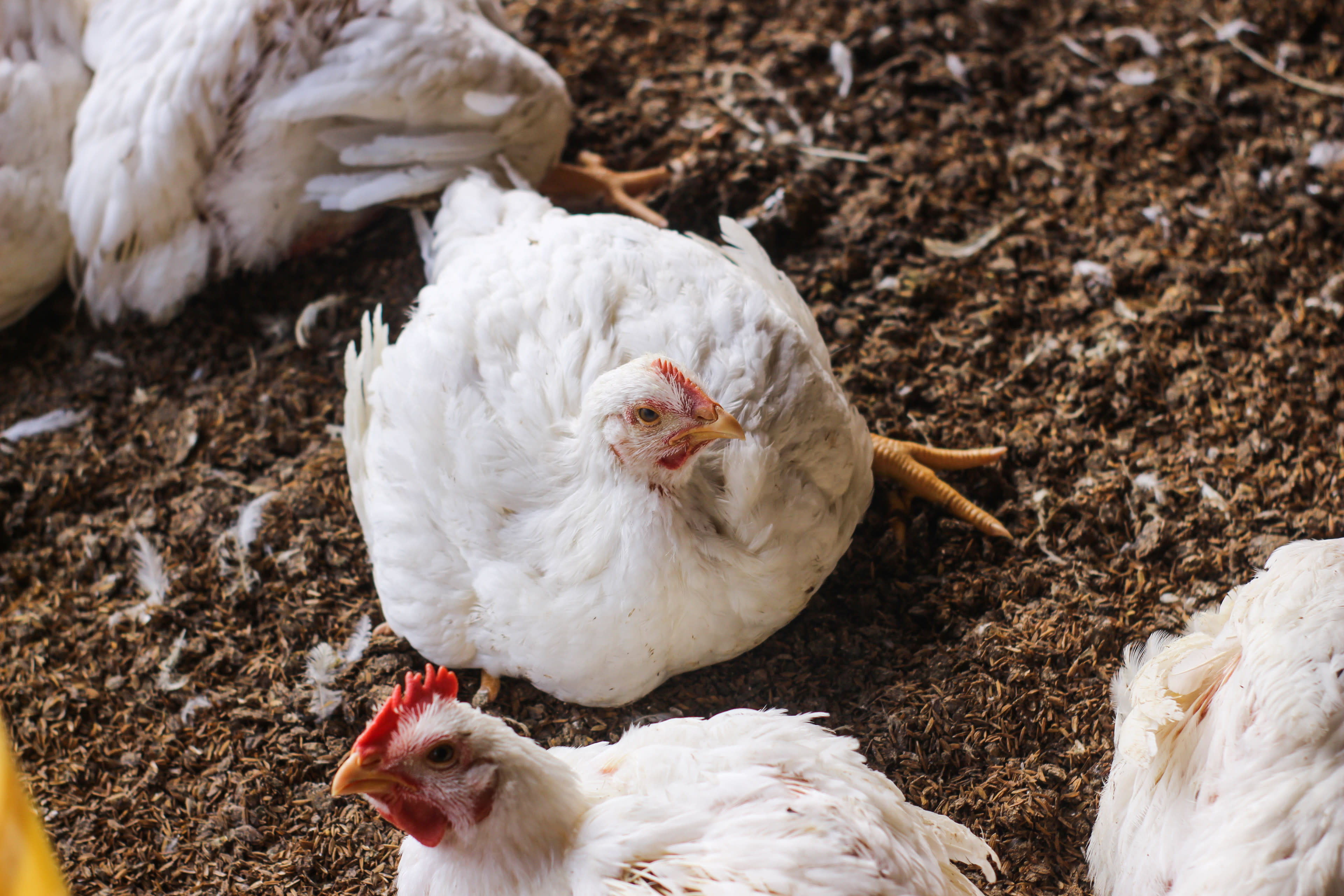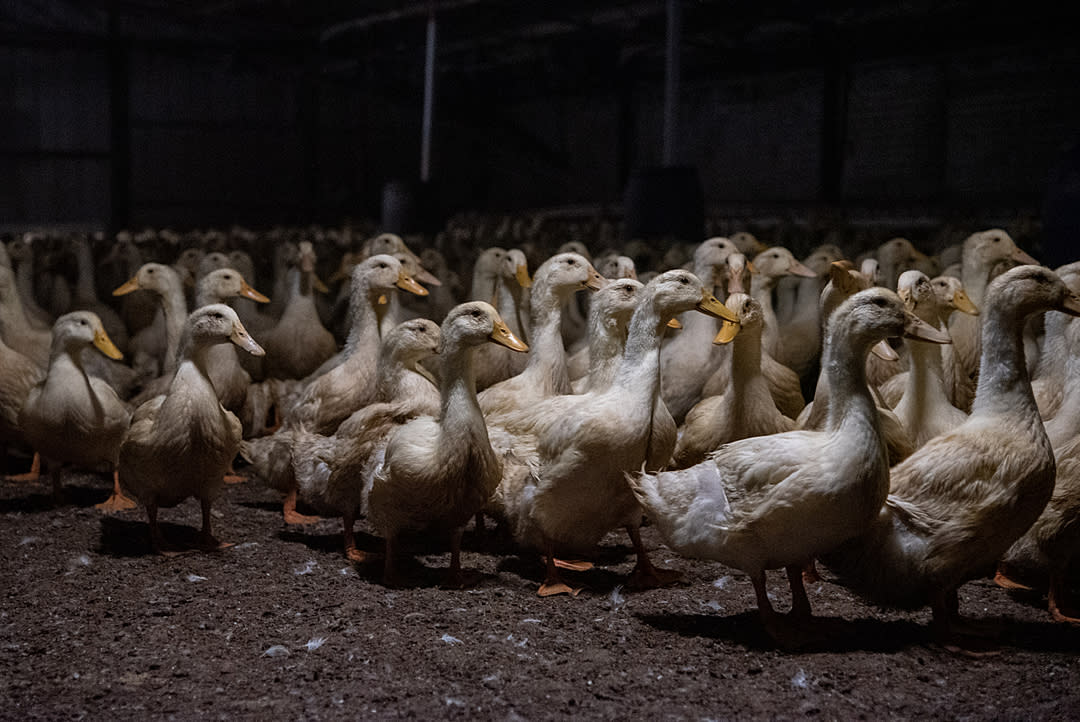




Because of human intervention, there are some breeds of chickens whose weight has drastically changed over a short amount of time.

If you took a stroll through the jungle forests of Southeast Asia thousands of years ago, you would likely come across colorful, crowing birds weighing in at under two pounds, leaping from branch to branch or scratching the forest floor.
The red junglefowl (Gallus gallus) is thought to be the original ancestor of the chickens that today languish in the appalling conditions of factory farms. Despite being relatives, these two birds look wildly different—all because of human manipulation.
The weight of a chicken may not seem all that consequential on the surface. But when you open the door of an industrial chicken shed, it’s clear that a chicken’s size amounts to a lot. A lot of weight. A lot of pain. A lot of disease. A lot of suffering. Their breasts are bigger, their thighs are plumper, and often, they can hardly stand under the weight of it all. But due to selective breeding practices, forcing chickens on factory farms to grow heavier than ever before—simply to satisfy the human demand for more white meat.
What's the Average Size of a Chicken?
There are hundreds of breeds of chickens living all around the world, yet in industrial factory farms, there is far less diversity. These recognized breeds are largely grouped into two categories: large and bantam, with the bantam breeds tending to be smaller.
In the US, nearly all of the chickens raised for meat and eggs are on factory farms in the most dire and dirty of conditions. Behind closed doors, they suffer moment by moment and day by day—notably because their bodies can’t support their oversized weight., Within these industrial farms, it’s typical to find two main types of chicken breeds. Hybrid White Leghorns are used in egg production, while chickens raised for meat are commonly a hybrid between Cornish hens and Plymouth Rock breeds.
Taking all of these breeds together, the average height of a chicken is estimated to be 27.6 inches tall, while roosters (male chickens) can have tails that grow to be close to 12 inches long.
What's the Average Chicken Weight?
Though chicken breeds vary in size and shape, with some featuring bigger plumage or weightier muscles, their average weight is around 5.7 pounds. However, in factory farms where they are selectively bred to grow so big, so fast, their average weight can be closer to 9 pounds when they are just two months old—more than four times the size of chicken raised for meat just 60 years ago.
How Much Does a Newly Hatched Chick Weigh?
Newly-hatched chicks are some of the cutest babies around, with fluffy yellow feathers and sweet chirping voices. Tragically, in egg production, all male chicks are considered useless since they cannot produce eggs, so many millions are killed, often within a few hours of being born.
Those chicks who survive gain weight rapidly. One study of Rhode Island Red chicks found that at about a day old, they weighed approximately 38 grams. By two weeks old, they were up to around 60 grams, and by a month old they can be 115 grams. Another study looked at broiler chicks and found that one-day-old chicks weighed around the same as the previous study, with a slight deviation when the chicks came from birds of different ages.
How Big Is a Full-Grown Chicken?
The average weight of roosters and hens can vary wildly depending on the breed. The information below comes from this list illustrating some of the more popular breeds of chickens and their respective weights.
Small Chicken Breeds
Among the smallest chicken breeds is the Sebright bantam. These tiny birds reach an adult weight of only 22 ounces as roosters or 20 ounces as hens. The Nankin breed can be similarly tiny, coming in at 24 ounces for roosters and 22 ounces for hens. Also on the smaller end of the spectrum are Araucana and Lakenvelder breeds, which weigh around 5 pounds for roosters and 4 pounds for hens.
Medium-Sized Chicken Breeds
Medium chicken breeds include Leghorns, at 4.5 pounds for hens and 6 pounds for roosters, and Wyandotte, Australorp, Rhode Island Red, and Delaware breeds, all of whom weigh roughly 6.5 pounds for hens and 8.5 pounds for roosters.
Large Chicken Breeds
Some chicken breeds can grow larger than you might expect. These heftier breeds—including Sussex, Plymouth Rock, and Orpington—can range from 7-10 pounds, while others can be larger still. Roosters from the Brahma breed can reach 12 pounds, with hens coming in at 9.5 pounds.
But among the biggest breeds in existence today are the Jersey Giants: These hens can reach 10 pounds, and roosters can weigh as much as 13.
Have Chickens Always Weighed the Same Over Time?
Natural selection and evolution mean that chickens in their current form have not necessarily always weighed the same. Factors such as natural interbreeding, climate change, and food availability can gradually affect the size of various bird species.
But because of human intervention, there are some breeds of chickens whose weight has drastically changed over a much shorter time.
Thanks to industrial farming practices, breeds of chickens destined for human dinner plates have undergone serious changes in just the past several decades. Known as conventional, or rapid-growth breeds, these chickens have been bred to put on a lot of extra weight as fast as possible—which comes at a serious cost to the birds. Their bodies aren't meant to support so much weight, so they fall prey to lameness, joint problems, and occasionally even broken bones.
The average chicken sold at market today is twice as big as it was in 1955. There's nothing natural or healthy about this explosive growth.
What Has Changed?
Rapid-growth chickens have been selectively bred by humans to reach a full-grown weight at only six weeks of age, much faster than regular chickens, for whom it takes around 12 weeks to become fully grown.
Chickens today grow more layers of white meat, rendering them essentially morbidly obese when compared with chickens who evolved without human intervention. They grow pectoral muscles (known as breast meat on menus) that are nearly 70% bigger than they should be. They also grow plumper thighs with bigger drumsticks in order to satisfy consumer demand for these meat products.
But faster and bigger growth comes at a serious cost for these birds. Chickens endure chronic pain because they're trapped within bodies that they can barely control. Leg problems inhibit them from walking. They can develop painful deformities and often have bad foot health, making every step excruciating. This inability to walk forces them to spend much of their time lying on barn floors that are covered with their own feces, which in turn burns their skin and can cause open sores and lesions.
Rapid growth also places more strain on birds' organs, including their hearts, so heart disease is a common killer of these breeds of chicken.
How Can You Help?
The Humane League advocates for the Better Chicken Commitment (BCC), in which major companies pledge to adopt more ethical chicken-rearing practices, including using chicken breeds that do not grow so fast or large, something that causes enormous suffering for chickens. If you learn that a food company you support has not adopted the BCC, pressure them to do so. You'd be surprised how much public opinion matters on these issues.
By taking action with The Humane League in our work to improve the welfare of chickens raised on factory farms, you can join a movement that has already achieved incredible successes. Finally, perhaps the easiest and most effective way to reduce the suffering of chickens is to curb or eliminate your consumption of chicken altogether.
Retailers, restaurants, and major food suppliers are beginning to wake up to the torture endured by these intelligent animals. With your help, the industry will change for the better.






